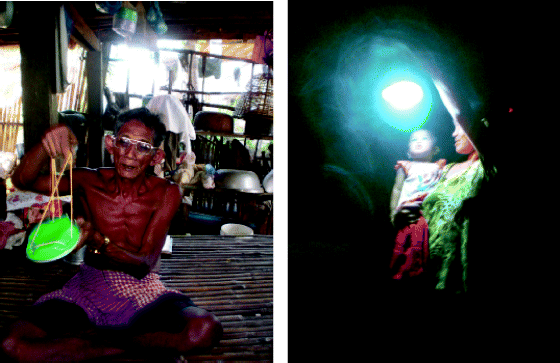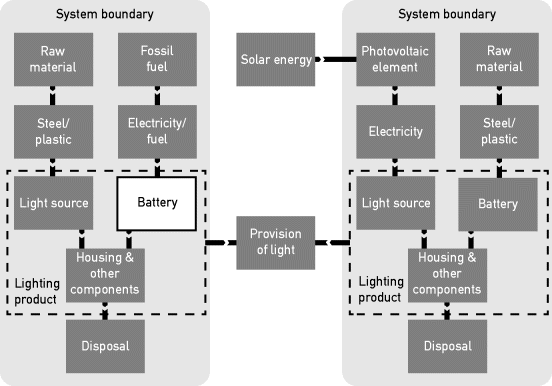B.1 Introduction
Photovoltaic (PV)–lighting products are increasingly used to provide rural households in developing countries with clean and safe lighting. These households commonly have no access to electricity from a power grid (Legros, Havet, Bruce, & Bonjour, 2009). They currently rely on either kerosene lamps or electricity from car batteries. PV-lighting products deliver a higher quality of service than conventional lighting sources; they are safer and more reliable (Figure B.1.1).
Figure B.1.1 Impressions of solar lighting, in this case the Moonlight manufactured for the Cambodian market

The PV-lighting products that are studied in this case study are designed for use in rural areas in Cambodia, where no electricity grid is currently available. The products are typically smaller than solar home systems in terms of both physical dimensions and energy capacity. There are indications that PV-lighting products are environmentally beneficial when compared to conventional lighting solutions. A method to qualify and quantify such an environmental benefit is through undertaking a life cycle assessment (LCA). This case study uses the LCA framework to assess the environmental impacts of the lighting products considered.
LCA is the process of evaluating the potential effects that a product, process, or service has on the environment over the entire period of its life cycle.
Figure B.1.2 illustrates the life cycle system concept of natural resources and energy entering the system while products, waste, and emissions leave the system.
Figure B.1.2 Life cycle system concept (International Organization for Standardization, 2006)

The International Standards Organization (ISO) has defined LCA as follows:
A compilation and evaluation of the inputs, outputs and the potential environmental impacts of a product system throughout its lifecycle.
(International Organization for Standardization, 2006)
An LCA consists of four main components of equal importance:
- Goal and scope, that is, definitions of the systems considered and what needs to be resourced.
- A life cycle inventory, a collation of all relevant process data including material use, energy inputs, and emissions.
- A life cycle impact assessment, relating the emissions to a discrete number of environmental impacts.
- An interpretation of these stages.
A system boundary describes the processes that are taken into consideration. For this particular case study, a system boundary diagram is shown in Figure B.1.3.
Figure B.1.3 Simplified diagrams of (left) a product system relying on an external power source, and (right) a product with integrated photovoltaics (PV)

The PV-lighting products considered in this study are sold to rural households in Cambodia to substitute kerosene lights, battery-operated torches, or candles. Some products have enough capacity to power more than just lights. However, for this case study these other functions are not taken into consideration (i.e., it is assumed that all energy is used for lighting). Because the lighting systems vary in size and capacity, it would be unfair to compare products one on one. Instead, the systems are compared by their delivery of a certain amount of service, in this case the provision of light. Therefore the following unit of service (or functional unit) is used in this study:
Functional unit: The provision of light, with strength of 100 lumens, for 3 hours a day, over a period of 1 year.
This functional unit represents typical lighting conditions for the range of products that are considered in this study. The systems can be compared by scaling them to this size (scaling the operation time and lighting strength). A lighting strength of 100 lumens is comparable to the amount of light that is emitted by an 8 W incandescent light bulb, or a 2 W compact fluorescent light bulb (CFL). Lights are typically used for 3 hours daily. The period of 1 year is included for practical reasons; it eliminates possible effects from seasonal differences (e.g., irradiation and operating time), so yearly averages are used. Also lifetimes of investigated products are expressed in years and can therefore more easily be compared to the functional unit.
